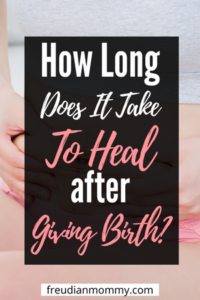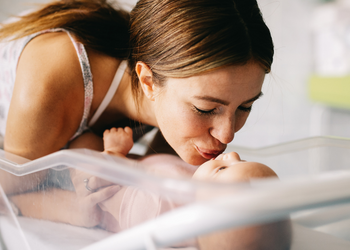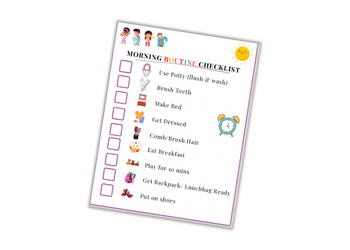Healing after giving birth is one of the most important steps in moving in the right direction and something all mothers look forward to. However, how long does it take to heal after giving birth? When can you move and feel like yourself again?
That’s the question this article is going to answer because if you are not healing as you should after childbirth, you want to know some of the problem areas to look out for so nothing gets in the way of you being able to take care of yourself and your baby.
Also read: 18 Best Postpartum Must Haves For Your Postpartum Care Kit
How long does it take to heal after giving birth?
Although it normally takes 6 weeks for your body to heal after giving birth, the recovery process after childbirth is different for every woman because not all women have the same type of birthing experience. Some women may be in recovery after vaginal birth without any assistance or a vaginal birth that required an episiotomy or forceps while others may have had a cesarean sec. Regardless of how you brought your baby into this world, by the 6th week your vagina, perineum and cesarean section incision is expected to be healed. And your uterus should shrink back to its pre-pregnancy size.
No matter what type of birth you had, your body just experienced an overwhelming amount of changes and physical trauma and is going to need some grace and time to recover from childbirth.
Things to consider when recovering from childbirth
To understand the length of time your body might need for healing after childbirth, there are a couple of things to take into consideration. Many things in your body have changed after giving birth, and knowing what changes have occurred will help you to better understand and tolerate the time it takes to recover from childbirth.
You may also like: 5 Simple Postpartum Depression Self-Care Ideas for Struggling Moms

Baby blues: Having a new baby can be overwhelming. A lot of moms, (about 80 percent) experience sadness, mood swings, difficulty eating, and sleeping, anxiety, and crying during the first couple of weeks postpartum. These feelings are known as baby blues and begin 2-3 days after giving birth. These feelings should be temporary lasting 1-2 weeks at the most. If you experience feelings of worthlessness and hopelessness for more than two weeks, you could be experiencing postpartum depression. Speak to your healthcare provider immediately as postpartum depression can affect how you care for yourself and your newborn baby.
Changes in hormones: After giving birth to your baby, the levels of estrogen and progesterone sharply decrease, this type of hormonal change in your body can make you feel tired and depressed. Be mindful of your feelings, so you can get help right away if you need it.
Vaginal bleeding: Vaginal bleeding also known as lochia is common after giving birth. And occurs whether you’ve had a vaginal birth or cesarean section. During pregnancy, your body produces additional blood to help your baby grow. Your body gets rid of the excess blood and tissues in your uterus needed during pregnancy through bleeding and discharge. And even though vaginal bleeding is heaviest in the first few days after childbirth, it is possible to have light bleeding or spotting for up to six weeks after giving birth.
Also read: Breastfeeding Must Haves: 3 Things That Made My Breastfeeding Experience Stress Free!
Abdominal pain: Not fun at all but you will have some sharp abdominal pain and cramping after delivery. This pain is mostly due to your uterus contracting and returning to its normal size. I do have to warn you though, this cramping is much worse when you’re breastfeeding for the first 2-3 days but does get better. The hospital gave me some ibuprofen to help with the pain.
Perineum soreness: It is common for the perineum, the small area between your vagina and anus to tear during childbirth. In fact, roughly 9 out of 10 first-time moms will tear during vaginal delivery. There’s also the potential for an episiotomy, a cut made by your doctor to widen your vagina for a more suitable delivery. Even if you don’t have a tear or episiotomy, your perineum will be sore and swollen from the stress of childbirth and will feel achy for up to 2-3 weeks. Using a peri bottle with warm water to rinse can help relieve some of the discomfort you feel from the soreness and stinging that occurs when you use the toilet.
Also read: 15 Stylish And Functional Diaper Bags That You’ll Love
Stitches: Depending on the degree of your tear, you may need to get stitches. First-degree tears are small and milder and only affect the skin and can heal fast without medical intervention. However, second-degree tears which involve the skin and muscle of the perineum require stitches to close. If you have stitches from a c-section, you may have more restrictions in order to heal.
Postpartum swelling: Swelling is a common and normal postpartum occurrence. Among other reasons, postpartum swelling is due to fluid that accumulated during the pregnancy phase and from additional IV fluids you received during labor if you had an epidural or cesarean section. Swelling or water retention usually occurs in the feet, legs, ankles, and face. Some moms even experience swelling in their hands and arms. Postpartum swelling could last up to two weeks.
Constipation: Regardless of how you brought your baby into this world, constipation is a common postpartum occurrence. Moving your bowels after childbirth can be a very unpleasant and painful experience and can cause a lot of fear and anxiety, especially if you had a tear that required stitches. Although a common occurrence, Talking to your doctor about taking a stool softener can make a world of difference in things moving regularly again. My doctor always advised Colace for all three of my postpartum recovery.
Also read: What To Pack In A Diaper Bag: 5 Useful Tips For New Moms
Hemorrhoids: The hemorrhoids (swollen blood vessels in your rectum) you developed during pregnancy from the pressure of your growing baby and constipation from the slowing down of your bowels can persist after you have given birth, especially from the straining and pushing during delivery. Hemorrhoids can develop inside and outside the rectum area, range in size, and can get itchy and bleed. They are ways to remedy hemorrhoids but it could take some time to get your rectal area back to normal.
Sore breasts/cracked nipples: If you haven’t breastfed in a while, the first week of breastfeeding may cause your breast to be sore and you may struggle with cracked nipples. Using a nipple cream can really help your nipples to feel better.
Breastfeeding: It is recommended that you exclusively breastfeed your baby for the first 6 months of life and continue breastfeeding the following six months along with complementary foods. I personally feel like I couldn’t get back to normal until I had gotten through the humps of breastfeeding my baby.
Weight changes: I am sure you’re looking forward to shedding those pounds that you gained during pregnancy, but don’t put too much pressure on yourself. Keep in mind that not all weight you gained during pregnancy will come off right away especially if you are breastfeeding. Eating an additional 500 calories a day is recommended if you are nursing and believe you will need those extras to help you maintain your energy to take care of your baby.

Tips for recovering for recovery from childbirth
As a woman who has given birth three times, each postpartum experience was unique. With my first child, I was fit and worked full-time until it was time for me to give birth. Recovery was difficult because I gave birth at a teaching hospital, and because my OBGYN wasn’t present when I gave birth, a resident took care of me including stitching me up. I don’t believe that resident did a good job with the stitches because even months after giving birth, I still felt that things didn’t feel quite right in my vaginal area,
With my second child, I knew what I wanted and how to articulate my medical needs. And although the epidural experience went WAY south, my OBGYN was present during my labor and stitched me up pretty good. The recovery process was much more tolerable than the first time around.
In the same way, when I gave birth for the third time, I knew I wasn’t going to let just any doctor take care of me. I gave birth at a hospital I did not plan to give birth at, nonetheless, when I realized that the resident assigned to take care of me didn’t have the skills to fulfill my medical needs, I requested to have the Attending stitch me up. That recovery, too, was very successful, thank God.
Use the following tips to help you in your journey to recovery after giving birth:
Rest and don’t do too much: How long does it take to heal after giving birth? That will all depend on how good you are at resting. Recovering from childbirth is a tough job, especially when there is so much to be done. But remember that doing too much can be counterproductive and possibly make your healing process much more challenging. Don’t lift anything heavier than your baby and learn to ask for help if you have people in your life who are there to support you.
Sleep enough: As little of it as you will be getting these days, get as much sleep as you can. You will inevitably be tired after giving birth ,and from the demand of taking care of your newborn baby, poor quality of sleep has been linked to postpartum depression. Choose to prioritize your sleep over any other chore to prevent sleep deprivation which can impair your ability to function.
Eat nutritious foods: Nutrition is an essential part of your recovery. Eating the right foods will provide your body with the nutrients it needs to heal, thrive, and beyond.
Move a little: You won’t be able to exercise until you get clearance from your 6-week postpartum visit with your doctor. Until then, it’s important to move around. Try to take a 5-10 minute stroll every day. The fresh air will be good for you and your mental health.
How long does it take to heal after giving birth














Trackbacks/Pingbacks